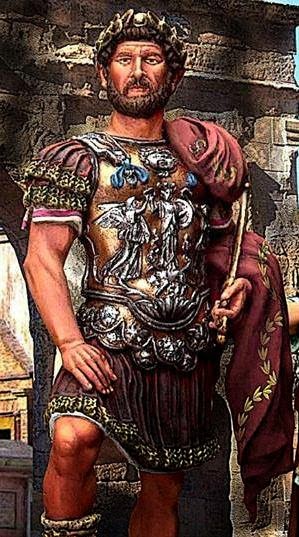by
Damien F. Mackey
“As Perowne emphasizes in his biography,
Hadrian seems
to have perceived himself as a second
Antiochus”.
But
maybe Hadrian simply was Antiochus!
Hermann Detering
has written of further (to what was noted in Part One of this series) parallelism between Antiochus ‘Epiphanes’
(so-called IV) and the emperor Hadrian. (Naturally, I would not accept the
author’s conventional BC or AD dates as given below):
THE SYNOPTIC APOCALYPSE (MARK 13 PAR):
A DOCUMENT FROM THE TIME OF BAR KOCHBA
….
Bar Kochba was the leader of a Jewish underground movement, which was founded
in 127, the year of Hadrian’s prohibition of circumcision, and in which the
Zealot-Maccabean traditions of the rebellion put down by the Romans in 70 lived
on.
The
actual causes of the war are debatable. It is most often thought that the Roman
emperor Hadrian (117-138) provoked the conflict through his prohibition of
circumcision in 127 and his announcement that he wished to erect a temple for
Jupiter on the place where once the Jewish temple stood. …. In Jewish
traditions it is often claimed that Hadrian had promised to rebuild the old temple
… but was prevented by intrigues of the Samaritans. ….
In
our immediate context, it is a matter of indifference why the war started.
Decisive is the fact that during his trip through his Eastern provinces in 130
Hadrian came to Jerusalem and issued the order to construct the city of Aelia
Capitolina and to erect a temple for Zeus. As long as Hadrian remained in his eastern
provinces, peace reigned. But once the emperor had passed through Syria and
Pontus to Greece the uprising under
the
leadership of Bar Kochba (132-35) began, since the Jews especially regarded the
construction of a temple to Zeus (and the image of the emperor) on holy ground
as an intolerable provocation, which reminded them of a traumatic event from
their past: the “desolating sacrilege,” i.e., the consecration of a temple dedicated
to Zeus Olympios in Jerusalem by the Seleucid king Antiochus the IV Epiphanes
in 168 BCE.
In
fact, the parallelism of the events is amazing. As Perowne emphasizes in his
biography, Hadrian seems to have perceived himself as a second Antiochus. In
summarizing the factors which excited the anger of the Jews against Hadrian,
Perowne makes all too apparent how many similarities connected the Roman emperor
and Antiochus Epiphanes:
First
of all, he designated himself as the successor of Antiochus Epiphanes. He even
saw to the completion of the temple of Antiochus in Athens. Secondly, like
Antinous, he elevated himself to the status of the God Zeus Olympios, or at
least permitted others to do so. Thirdly, he allowed his visage as one deified
to be stamped on coinage which circulated in Jewish communities as well.
Fourth, he proscribed circumcision, the seal for Jews of their nature and
faith. Fifthly, he was on the way to flatter the Greeks of Alexandria who were
renowned as the most impassioned haters of the Jews. Sixth, he interrupted a
trip to specifically honor a man who had conquered Jerusalem almost two hundred
years before and desecrated the holy of holies. And finally, seventh, he gave
the order to eradicate Jerusalem and build a Roman colony on its site which was
to be named after himself and would include a sacred sanctuary in which he was
worshiped as God precisely on the ground where the ancient temple had stood. ….
Just
as the desecration of the Jerusalem temple by Antiochus Epiphanes in 168 BCE
became the incentive for the uprising of the Maccabees, so also this time
Jewish resistance rose up against the erection of the temple and the related oppressive
measures undertaken by Hadrian whose goal was the dissolution of Jewish
identity. ….
The parallels outlined here - which are
only some of many - are impressive enough to make a revisionist historian wonder
if there is a compelling need for a compression of Seleucid and so-called Roman
Imperial history here.

No comments:
Post a Comment